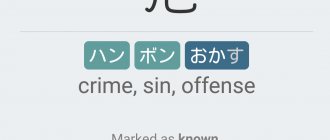Greetings friends, Igor Korotkov is with you. You are on the website Venasera.ru
When you first think about starting to learn Japanese, most often people start Googling something like this: “ Japanese language tutorial for beginners ” or “ Best Japanese language tutorial ”.
If you think that buying a tutorial is a good idea, then I want to upset you . Tutorial teachers will assure you that you will learn Japanese in 10-15-30 days. But no matter what tutorial you choose, there will be very general and scattered information, and even more so there will be no talk of any 10-15-30 days.
In order not to waste time and money , I suggest immediately paying attention to Japanese language textbooks .
In the previous video I talked about some of them, but times change, and some textbooks, unfortunately, do not. But fortunately, new worthy textbooks are coming, which we will also discuss today.
For example, you can safely cross Golovnin’s textbook .
This textbook has been morally outdated for a long time, but until recently I held out hope that there would be some new editions with worthy updates.
List of tutorials
- “Reading, writing, speaking Japanese” , authors Strugova and Sheftelevich. The textbook contains the most necessary materials and topics for learning Japanese - tests, practice, grammatical explanations, hieroglyphics lessons, as well as copybooks.
- “Japanese for Beginners” , author L. T. Nechaeva. This textbook is popular in educational institutions for its competent presentation of material and a lot of exercises. Excellent explanation of grammar is a clear plus of this manual.
- "Modern Japanese Course" by Hiroko Storm. This textbook does a great job of teaching grammar. It is well structured and provided with audio materials.
- Minna no-nihongo . This textbook is written entirely in Japanese and includes several types of aids. There is even an addition on writing essays, on hieroglyphs, a book for reading and other materials.
L.T. Nechaeva. Japanese for beginners.
Absolutely the same applies to Nechaeva’s textbook . These 2 textbooks (by Strugov and Nechaev) are very competently compiled, but this was relevant at the time the textbook was created, and now I would like more lively vocabulary and more real life situations, and not dialogues like: “Let's ride Dumbo the elephant?” (as it is written in Strugova) or “Do you listen to cassette tapes in class?” (in Nechaeva and Strugova) Why do such offers for a beginner? I don't understand!
In addition, many texts and vocabulary in these textbooks revolve around the topic of studying, which is also a little strange, because... Not everyone learns Japanese in order to say sentences like “I study Japanese from 9 am to 5 pm.” But all the same, all these disadvantages are covered by the very strong base that is presented there.
Dictionaries
YARKSI - this site is recognized as one of the best Japanese-Russian hieroglyph dictionaries. You can download it to your smartphone or computer, and you can also find the hieroglyph by simply drawing it with your finger!
Warodai - this site took Conrad's dictionary as a basis and compiled it into an electronic version. The volume of words is about 150 thousand; The dictionary can be downloaded in different formats.
Kanjiname is a convenient dictionary divided into topics and categories.
Japanese alphabets
While Japanese grammar, basic phrases and Japanese pronunciation are quite simple, the rules and alphabet are complex. So, there are 46 basic sounds, of which five are syllable-forming. But there are four alphabets, and each of them has its own specific use.
Hiragana is used for writing. This is a syllabic alphabet. Unlike the Latin alphabet, which is familiar to us, here each symbol represents a syllable with a consonant and vowel sound. Variable parts of words and grammatical particles are written in hiragana.
Kanji is a writing system originally from China. If hiragana is a phonetic letter, then kanji is ideographic: all characters have their own meaning. There are many thousands of characters, but the most popular are about 2000 hieroglyphs.
Katakana, like hiragana, is a phonetic and syllabic letter. Used in conjunction with hiragana to denote onomatopoeic and foreign words. In katakana, 1945 characters are approved and considered necessary, which makes learning a little easier.
Romaji is the Latin alphabet. It is actively used in Japan by those who are just getting acquainted with the language. But you won’t be able to use it alone, don’t get your hopes up.
Applications
busuu - this application has a huge number of users around the world and offers learning a foreign language without any extra effort. However, please note that the service is suitable as support for language learning, but not the main material.
memrise - this service is aimed at practicing vocabulary in learning foreign languages, in particular Japanese. There are many exercises here to help you maintain your practice at any time.
Learn Japanese - the application will help you quickly and easily get to know the language. It was developed jointly with the Japanese, so the accuracy of the translations is ensured.
Try and Dekiru Nihongo
I completely agree with him that Try and Dekiru Nigongo are simply excellent textbooks with their shortcomings, which have already been mentioned, I will not repeat.
Let me just say that both Try and Dekiru Nigongo can be recommended in addition to self-study, because... both here and there there are scripts with answers.
But they should be taken as an addition, and not as a basis, i.e. You need to already know the Japanese alphabet Hiragana and Katakana, as well as have some grammar and vocabulary. By the way, I advise you to watch this video to quickly get into Japanese without any problems.
Websites
Japanese language online - the site contains a good selection of materials for learning: grammar, videos, vocabulary for levels from beginner to advanced. You can also prepare for exams separately and read interesting articles about Japan.
Krakozyabr - the portal contains useful materials on grammar, vocabulary, punctuation, and hieroglyphs. There are texts to read in Japanese.
Ninna no Nihongo - we have already mentioned this portal above. There is a huge database of materials on all aspects of language in theory and practice. The resource offers lessons, preparation for exams, and studying a database of hieroglyphs.
First lessons from Naoe Nagonuma - this site has a selection of 40 basic Japanese lessons. Classes are constantly updated.
Orient Express - a site dedicated to the culture of the Land of the Rising Sun. There are materials related to culture and traditions, as well as lessons, reference tables, textbooks and audio recordings.
Japanese
The Japanese language category contains free online video lessons on learning this foreign language. Japanese is the official language of Japan. The bulk of people who speak Japanese live in the Japanese archipelago. Partially used in Korea, Taiwan, China. Japanese is studied in schools in most countries in Asia and Oceania. The number of fluent Japanese speakers is approximately 140 million. Native to 125 million people (9th in the world). Japanese writing consists of three main parts - Kanji (Chinese characters), and two syllabary alphabet - Kan. Learning Japanese using video lessons will be useful for both beginners and more experienced translators. You can watch video lessons from the Japanese language section for free at any time. Some Japanese video lessons come with additional learning materials that you can download. Enjoy your learning!
Total materials: 19
Materials shown:
1-10
Pages: 1
»
Sort by: Date · Title · Rating ↓ · Popularity
Watch lesson online
Learn Japanese on your own. Course for beginners. Basics, phrases of the day
It talks about how to learn Japanese on your own, a course for beginners, the basics, phrases of the day. The training is conducted by Japanese language teacher Marat. In this video lesson we will talk about the most common words that are found in normal everyday conversation. These are words of greeting. The course covers issues such as vocabulary, grammar, morphology, syntax, phonetics, writing and speech etiquette. The vocabulary of the Japanese language consists of three main sections - these are ...
- Language training
- Japanese
- Duration: 9:27
- Date: 07/19/2013
- Views: 1440
- Rating: 5.0/2
Watch lesson online
Japanese language. Predicative adjectives, basic conjugation
Online lesson “Japanese language. Predicative adjectives, conjugation based on the basics" is devoted to the question of the basics of predicative adjectives. Adjectives denote the attribute of an object and answer the questions what? whose? Japanese adjectives act in a sentence as a modifier or a nominal part of the predicate. The peculiarity is that they do not have the categories of gender, person and number. In Japanese, adjectives are divided into predicative, semi-predicative and non-predicative. In that…
- Language training
- Japanese
- Duration: 6:02
- Date: 09/06/2013
- Views: 218
- Rating: 3.7/3
Watch lesson online
Learning Japanese from scratch. Practical writing lesson - Hiragana
Video lesson “Learning Japanese from scratch. Practical lesson on writing - Hiragana" is devoted to the question of how to learn to write in Japanese. This is the first practical lesson in this writing course. Here you will learn how to write hiragana. You will be presented with a table that will help you master the material faster. To study writing, it is recommended to use just such tables, because all the symbols are numbered and indicated by arrows...
- Language training
- Japanese
- Duration: 10:03
- Date: 09/03/2013
- Views: 310
- Rating: 5.0/1
Watch lesson online
Japanese for Beginners - Gojuon Alphabet
This online lesson explains how to learn Japanese through short video lectures. Here we will talk about the Gojuon alphabet. Gojuon is analogous to an alphabet, a way of ordering kana characters. Used to write both hiragana and katakana characters. The Gojuon table developed around the ninth to tenth centuries. In its original version, it consisted of fifty characters - ten columns and five rows. Then some signs stopped being used, and now Gojuon...
- Language training
- Japanese
- Duration: 10:04
- Date: 08/30/2013
- Views: 376
- Rating: 5.0/1
Watch lesson online
Japanese language course for beginners. Subject and interrogative pronouns
This video is about subject and interrogative pronouns in Japanese, such as this, that, that, who, what, where, etc. Subject pronouns include the words - this, this, that, that. Question word - which one? Which one of? Subject pronouns indicate the location of the subject in relation to the person speaking. Subject pronouns can replace nouns of inanimate objects and can take second-hand indicators. In the defining position, i.e. before…
- Language training
- Japanese
- Duration: 6:43
- Date: 09/05/2013
- Views: 123
- Rating: 0.0/0
Watch lesson online
Japanese language training. Personal pronouns - table, examples
This online lesson explains what personal pronouns exist in Japanese, with a table and examples of use. Personal pronouns such as I, you, he, she, they, etc. will be studied here. In the table below you will see the first person, second person and third person plural and singular pronouns. You will be presented with several options for Japanese pronouns, with guidelines for using each one. In addition, some…
- Language training
- Japanese
- Duration: 10:29
- Date: 09/05/2013
- Views: 117
- Rating: 0.0/0
Watch lesson online
Learning Japanese. Cases
Video lesson “Learning Japanese. Cases" is devoted to the issue of declension of Japanese nouns. We continue to study cases. The remaining five cases will be considered here. There are eleven in total, six of which were studied in previous lessons. You will learn what the directive, collateral, initial, initial-comparative and terminal cases are. The directive case is used to indicate the direction of movement and the addressee of the action. The joint case is used for...
- Language training
- Japanese
- Duration: 6:41
- Date: 09/05/2013
- Views: 100
- Rating: 0.0/0
Watch lesson online
Japanese for beginners. Accusative and instrumental case
It talks about what the accusative and instrumental cases are and how to put a word in the form of these cases. This is a continuation of a series of video lessons dedicated to noun declension. In previous lessons you have already become familiar with some cases, and it is time to study the accusative and instrumental cases. The accusative case has a special indicator in the form of an icon, with the help of which the letter indicates that this or that word belongs to this case. Here…
- Language training
- Japanese
- Duration: 3:47
- Date: 09/05/2013
- Views: 86
- Rating: 0.0/0
Watch lesson online
Japanese language course - genitive and dative case
This video shows you how to put a word into the genitive and dative forms in Japanese. The genitive case is one of the indirect cases expressing possessive relations, i.e. relations of belonging. In Japanese, a special symbol is used to denote a noun in the genitive case, which will be presented in this online lesson. There are also several examples using this sign. It is worth noting that the definition...
- Language training
- Japanese
- Duration: 5:21
- Date: 09/05/2013
- Views: 94
- Rating: 0.0/0
Watch lesson online
Learning Japanese from scratch. Nominative case, thematic and rhematic
Lesson “Teaching Japanese from scratch. Nominative case, thematic and rhematic" is devoted to the question of how to learn to speak Japanese in a short time and master the basic rules of grammar with the help of a special mini-course for beginners from an experienced teacher. The study of Japanese cases will continue here. There are a total of eleven cases in the Japanese language, and now you will become familiar with the nominative case, which is divided into the nominative thematic and...
- Language training
- Japanese
- Duration: 5:10
- Date: 09/04/2013
- Views: 151
- Rating: 0.0/0
1-10
11-19
How long does it take to learn Japanese?
How long does it take to learn Japanese? Each student learns the language at his own pace. For example, offline courses require a 3-year course. This is six months for each course. This is an average pace of learning - they master writing and reading, communication, and listening comprehension. But even here you will not get a 100% guarantee that you will know the language. Guarantee on basic skills - definitely. This will provide the basis for future independent mastery of the basics of the language. Living in Japan - the language itself, spoken language is mastered much faster.
Features of the Japanese language for children
When teaching children, classes are conducted in a playful way. The work uses colorful manuals, songs, poems, fairy tales, and interactive video programs. Children participate in theatrical performances.
The child is introduced to the history of the country, culture, and national characteristics. During training, thanks to a special alphabet and the logic of constructing sentences, memory, thinking, and imagination develop. At the same time, native speech improves and hearing develops. Children get acquainted with the sound diversity of the world. Their research interest is awakened. For many children, Japanese calligraphy later turns into a hobby.
"Varibrus"
Official website: https://www.varibrus.com/japan/
Linguistic has been operating since 1991. Training is based on the communicative method. Communication, dialogues between teachers and students, grammar are the characteristic features of the program. Conversations are successfully combined with grammar, audio, and video. Various programs, news, videos, stories and films are used.
Students repeatedly review the material, write it down, memorize unfamiliar words, compose dialogues in writing and orally, quote phrases, and retell texts. The exercises correspond to the students’ level of preparation and gradually become more complex as their language skills improve. Certain stages of training are accompanied by testing. The school also recommends attending free seminar lessons on various topics, including grammar, analysis of news and songs. Free meeting-lessons with Japanese will also help you quickly master the living Japanese language of the Hirogana and Katakana alphabet. In 25 hours, the number of hieroglyphs mastered is 50...70.
Varibrus courses overview
Language offers many interesting programs:
- conversational Japanese;
- business communication training;
- training of tourism managers and representatives of the hotel business;
- emergency preparation of students for exams;
- intensive Japanese language course.
The forms of training are also diverse. Individual training meets the interests and professional needs of students. An economist will enrich the vocabulary with thematic terms, a tourism business manager will work on video reports on the hotel business of popular resorts around the world. A specially designed tailor-made course is available to company employees. Corporate clients of Varibrus are also pleased with the choice of programs: a basic course in general Japanese, business etiquette, and conducts business trainings.
The course teacher is Snezhana Kuleshova, who completed a course in linguistics at the Euro-Asian Higher School in Osaka. She lived in Japan for a long time, worked in the cities of Kyoto and Osaka. In 2002, she was involved in translations at the World Football Championship. She taught the Japanese Russian grammar.
Training rates (rubles/hour):
2 students - 1000;
3 listeners - 800;
4 people - 650.
Individual lessons cost 1,600 rubles for 60 minutes. The schedule is agreed upon with the teacher.
ANO "Japanese Center"
Official website: https://jc.org.ru/ru/index/
ANO "Japanese Center" provides training and education for Russian specialists with the support of the Japanese Embassy. Preference is given to enterprise managers and businessmen. The structure of the autonomous non-profit organization is represented by the head office in Moscow (based on Moscow State University), five branches in the regions of Russia.
Admission conditions
Training at the Japanese Center is based on a preliminary interview, a competition of questionnaires, and written testing. Russian citizenship is required. Taking courses is prohibited for minors, as well as students studying Japanese at other universities and colleges. The organization's programs provide initial and intermediate levels of training. Study materials are provided for the duration of the course.
Training levels:
1 year - 1 degree of initial training;
2nd year - 2nd degree of basic training;
3rd year - 1st intermediate level;
4th year - 2nd level of intermediate training, business level;
5th year (Senmon) - business Japanese.
Upon completion of individual courses, the Japanese Center ANO issues a state standard certificate.
Advantages of ANO "Japanese Center"
The organization has been operating in Moscow since 2000, its rich experience has allowed it to:
- select the best teachers;
- establish quality control of training;
- collect additional material that fills gaps in the knowledge of lagging students;
- provide assistance in purchasing textbooks.
The activities of the “Japan Centers” help to establish business ties, economic cooperation between countries, and deepen understanding of Japan. Those wishing to study language, culture, traditional and business etiquette throughout the year are offered many events in Moscow dedicated to the Japanese language, translation, and economic aspects. The organization strengthens business relations between countries by establishing business contacts between representatives of small and medium-sized businesses. Classes at the Japanese Center are taught by employees of the Lomonosov Moscow State University ISAA.
Enrollment of Japanese language course students is held annually on the 20th of April. Duration of training: 4 years, twice a week for 120 minutes.
The Difficulties of the Japanese Language
Difficulties in learning Japanese are associated with such features as:
- Complex writing system. The language has 3 alphabets: hiragana, katakana and kanji (hieroglyphs, curly characters). The first is used for Japanese words, the second for borrowed ones, and curly signs are constantly used when writing. Moreover, in 1 sentence you can find all 3 alphabets. As for the first 2 alphabets, you can still cope with them; the main difficulties arise with hieroglyphs. The exact number of kanji is about 5000. You need to learn a minimum of 2000 curly characters.
- The importance of understanding context.
- Counting suffixes. First you need to learn numbers, then counting words, and then counting suffixes.
- High pronunciation speed - 7.84 syllables per second.
- Small number of possible sound combinations. Most words sound similar. Sometimes they can be distinguished only by the fact that in one word the letter is pronounced a little longer than in the other.
Kanji symbol as one of the writing systems.
WHY TEACH JAPANESE LANGUAGE FOR CHILDREN
In general, what are we trying to achieve? While there is a wave of interest, I want the child to learn to recognize about 20-40 hieroglyphs without much difficulty and to know about a hundred words. Well, and in between, without drawing special attention, try to learn at least half of the alphabet signs and remember a dozen etiquette expressions for the rest of your life.
This is the seed. If the interest continues (the main thing here is not to scare it off), then good - in any case, the seeds will be planted, and someday it will sprout. And if her appetite is whetted, then well... let's continue. And if not, then, as they say, thanks for trying.
Recommendations for beginners
To take your first steps in learning a language, you should adhere to the following recommendations:
- Set a goal - why you are learning the language.
- Exercise regularly. It's better to do it a little often than rarely and for a long time.
- Learn syllabic alphabet. First you need to learn 92 katakana and hiragana characters.
- Do not set the option to remember all hieroglyphs (5000) at once. Even the Japanese learn kanji throughout their lives. To study, it is worth using proven memorization techniques. To understand the language, only 1000 characters are enough, and to pass the test at a high level – 1500-2000 characters.
- Practice your pronunciation regularly.
- Constantly expand your vocabulary. This should be done in parallel with practicing pronunciation.
- Make contact with others who are at the same stage of learning Japanese. Communication on sites will help you stay motivated, receive valuable advice, and avoid common mistakes.
- Immerse yourself in the environment. The language environment - media, books, films, music, anime - should be everywhere.
- Study the history and culture of Japan.
Many Japanese schools offer language tours. Winning competitions can provide this opportunity for free.










